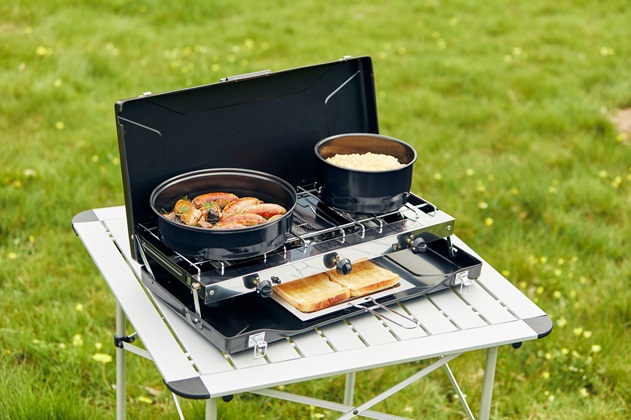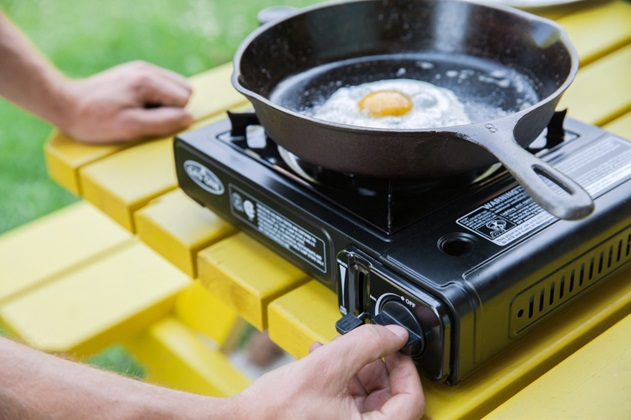Camp Cooking 101: How to Choose the Ideal Portable Stove
Whether getting back to a camp after a long day of adventuring, or relaxing in nature for the weekend with friends, mealtime is an important and necessary part of the process. In addition to being essential for fuelling your daring adventures, a hot, hearty supper can also raise your spirits and keep you in an adventurous mood.
Nobody wants to eat lukewarm or cold chilli con carne outside on a hillside during a downpour, after all. Having the right tools for the job can mean the difference between a tedious chore and a raging good time. And by the right tools, we mean a reliable camping stove.
What to Look for When Buying?

Make delicious meals and dish preparation a breeze with high-quality portable gas burners that are made to last. But, how on earth do you pick the best one for you when there are so many options available? Here, we cut through the lingo and list some of the most important factors to take into account when shopping. Plus, we have gone the extra mile by highlighting the best features to look for in a camping stove.
Camping or Backpacking Stove?
The distance between your automobile and your backcountry kitchen will determine whether or not you want a car camping stove. We refer to it as car camping since you should use a camping stove if you intend to prepare food close to your vehicle. A backpacking stove, on the other hand, is a better choice if you want to prepare meals more than a quarter mile from your car, or backpack, or travel with your gas stove.
Car camping stoves are frequently heavy and difficult to transport very far from your vehicle. Most of them are sizeable, varying from moderately compact to very enormous, and operate similarly to the stove in your kitchen at home. This implies that you can prepare more elaborate multi-pot meals than a freeze-dried backpacker meal.
Additionally, automobile camping stoves are constructed of more robust materials and can fit common kitchen cookware, such as cast irons and woks. Backpacking stoves, on the other hand, are smaller, lighter, and more fuel-efficient. Some are only capable of boiling water, while others can fit a pot or pan to prepare a whole meal.
Size
The amount of people you intend to feed and whether you prefer a tabletop or freestanding stove are the first two things to think about when deciding what size of portable gas burners you should buy.
The two main types of camping gas stoves are the little tabletop ones with 1-3 burners, and the huge freestanding ones with their legs and 2-3 burners. If you don’t mind getting on all fours, tabletop models are best used on a table or tailgate. These camping stoves have a smaller cooking surface than freestanding units, so you might have to use smaller pots and pans.
Freestanding alternatives, on the other hand, can be placed on a tailgate or table in addition to standing on their own two legs. If you want to prepare meals in a large stockpot or wok for each meal, the freestanding type is the right one for you because it has greater cooking space and bigger burners.
Boil Times and Burner Power Output

The power of a portable gas stove is measured in watts. For three-season camping in the Australian mountains, 2,500W serves as a reasonable benchmark. While it’s helpful to verify these parameters, a stove’s usefulness isn’t just dependent on its amount of raw power. Performance will vary depending on a variety of additional variables, such as wind protection, heat exchange, and the type of pot you’re using.
However, in general, you will see a faster rate of water boiling the higher the burner power output. Based on their experiments, several manufacturers give an official boil time for either 500ml or 1l of water. For 1l of water, the official boil time is typically 4 minutes, but some latest super-fast stoves claim to be able to boil 500ml in just 100 seconds. This quick technique can completely transform the game for some people, but for others saving a few minutes during a wild camp is of no consequence.
Burner Head Size
A stove’s burner head can range in width from around 2 cm to 5 cm. If you don’t stir your food frequently, a narrow burner head will concentrate the heat in a small area, increasing the risk of food-burning hotspots.
On the other hand, a larger burner head will spread the flame more evenly, minimizing the risk of hotspots. A small burner head won’t be an issue if all you’ll be doing is boiling water for adventure meals, but if you’ll be making soups or pasta dishes, a wider flame with greater heat distribution would be helpful.
Flame Adjustment/Regulation
Most contemporary gas stoves for camping have a control valve for changing the flame’s intensity. A regulated stove with accurate flame adjustment would be helpful if you plan to prepare more complex meals that necessitate simmering or low to medium heat. Flame adjustment is far less crucial while merely boiling water because you’ll almost certainly only utilize the highest power level.
Additional Features
Even though we have discussed all the important features of a gas camping cooker, certain specialty stoves also offer specialized features. For instance, when the gas canister is turned upside down and balanced on flip-out legs, as is the case with some hose-fed stoves, liquid fuel is delivered to the stove, allowing it to function efficiently in below-freezing temperatures.
Other cool features to look for are insulating pot sleeves, a heat indicator that changes colour to indicate when the water has boiled, built-in cups, and a perforated lid that serves as a strainer.



